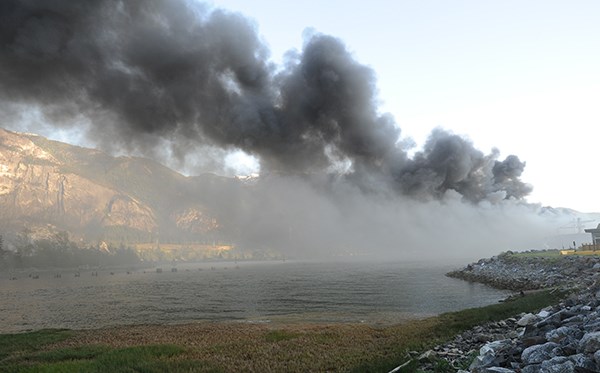In Hamlet, Act. 1, Scene 4, Marcellus announces “Something is rotten in the state of Denmark.” That classic line has no geographic or temporal boundaries. When it comes to pinpointing rot, and the malodour emanating from it, we need to sniff no farther than the top of Howe Sound.
But first let’s take our hats off to all the emergency staff, volunteers, and out-of-town personnel who fought the stubborn dock fire last week. Without their persistence, this episode could have morphed into a far more serious event. As it stands, instead of a major disaster we are left with a cautionary tale.
Praise must also be extended to our mayor whose leadership under duress was commendable. And kudos should be directed at Squamish residents who toughed it out with only minor complaints, especially those living in proximity to the fire.
That being said, what stinks as much as the acrid smell of burning creosote is the indefensible lack of preparedness by local officials. In the past 10 years, over $11 million and hundreds of hours have been allocated to getting the Squamish oceanfront development ready for market. We spent the better part of two years and $63,000 on a branding initiative that resulted in a new tagline, a glossy 94-page booklet and plenty of feel-good recommendations. We are in the process of updating our Official Community Plan which, according to one report, will be enacted in November 2016 and end up costing taxpayers $580,000. In other words, money is no object and planning time is elastic when it comes to high-profile projects.
The District of Squamish website tells visitors, “There are many reasons why a business investment in Squamish makes sense.” Those reasons include a deep sea port, as well as rail and major highway links. But, as we now know, limited attention has been paid to a comprehensive emergency procedures plan, or the necessary equipment to adequately deal with a potential calamity on our oceanfront. Does that make sense?
As the blaze lurched out of control, two hours passed before a fire boat arrived from Vancouver. Instead of handling the situation in a timely and efficient manner using local resources, the district was compelled to rely on another jurisdiction some 70 kilometres away.
Two months ago, council declared its support for the right of all inhabitants “to continue to breathe clean air, drink fresh water, consume safe food and to access nature.” Following last week’s emergency shelter-in-place order, how are we doing with that concept?
We lay claim to being an unparalleled outdoor recreation hub and municipal officials promote this community’s pristine environment at every turn. Yet when push came to shove, they failed to protect the integrity of our natural endowment. Does that make sense?



